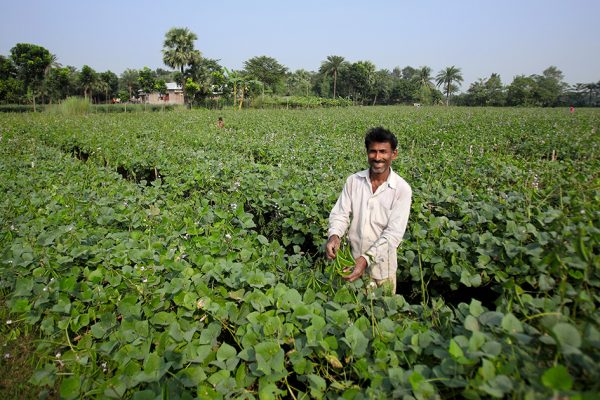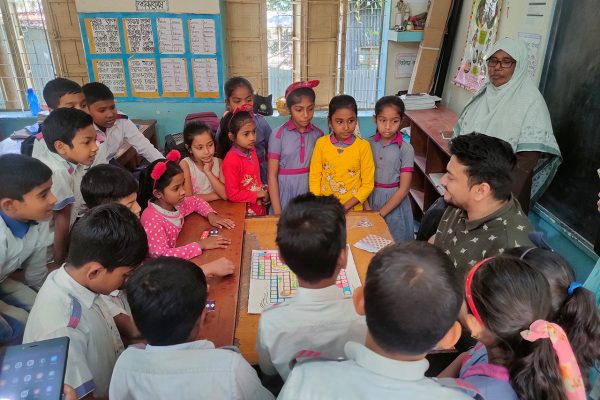Client Interaction Points: How BRAC is facilitating RMG workers to access financial services in Bangladesh
Reading Time: 3 minutes
Workers in the readymade garments (RMG) industry in Bangladesh have taxing working hours every day. By the time their shifts end, it is usually time to go home and prepare for the next day. In order to access any financial services on a workday, they mostly have to take a leave or travel far, resulting in a pay cut at work. Against this backdrop, BRAC’s client interaction points (CIP) work as a service point for RMG workers to access financial services.
Bangladesh had an export value of USD 34 billion in 2019, as the world’s second-largest exporter of apparel products (Export Promotion Bureau, 2020). The growth in the RMG sector has significantly contributed to women’s empowerment and employment in the country. According to The Global Economy, the latest female labour force participation rate In Bangladesh is 36.37 percent (2019). Women comprise 70% of all RMG workers in Bangladesh, yet most of them have remained unbanked (ERMG Project, BRAC). Although RMG workers are included in the labour force, countless women are not a part of financial inclusion nets due to inadequate access and information.
Read more: An innovation fund for the RMG sector
Following consumer footprint
Financial inclusion denotes the knowledge of utilising one’s income or savings wisely. While looking into the microfinance needs in urban areas, BRAC discovered the urgent demand for quick transaction facilities to cater to the busy schedules of its urban clients. The programme, therefore, decided to customise its intervention for the people, especially women, who are stitching together the billion-dollar apparel industry.
BRAC Microfinance aims to empower people with financial tools and information, leading to the creation of the Client Interaction Point (CIP). It is a fast-track financial service point for clients in the RMG sector to improve access to financial services.
Watch: What is financial inclusion?
Client Interaction Points: An innovative solution for quick access to finance
Bina Begum is an RMG worker who lives in Narayanganj with her family. Her husband was unemployed for a long time and it was getting increasingly difficult for her to provide for the family with her sole income. “It was incredibly hard to survive solely on my income,” says Bina. “We thought of buying a rickshaw so my husband could earn through it, but we did not have the money. That’s when I came across BRAC’s CIP office beside my workplace. My husband and I dropped by the office during my lunch hours and availed a loan of BDT 30,000 (USD 353) for the rickshaw. Surprisingly, the loan was processed within three to four days. While there, I also opened a DPS worth BDT 500 (USD 6) for my own savings,” says Bina.
Currently, Bina and her husband are both earning a steady income, and are able to provide for their children. She is happy that service points such as BRAC’s CIP can fast track transactions so quickly for someone as busy as her.
Read more: Women challenging poverty in Bangladesh
‘Meeting clients where they are’ has always been BRAC’s ultimate goal for service delivery. The CIPs work as service points for RMG workers to facilitate access to crucial financial services, becoming an invaluable tool due to their close proximity and efficient service through DFS (digital financial services). Through an end-to-end digital transaction process, clients can directly avail loans, deposit instalments and savings via cash or bKash.

Photo Credit© BRAC
Traditional vs Unconventional
The CIPs have been an excellent metric of success for digital financial services, with a visible increase in bKash wallet users and digital interventions. The outlook and interior of the CIPs have been renovated to make the environment more welcoming for the clients. It has also been designed to provide the swiftest service within minutes, as most RMG workers visit during their lunch hours.
There are currently 2,845 active clients at six CIPs located near garment factories in industrial areas. Majority of these clients are women, who have either availed loans or started saving via DPS. Each CIP provides services to an average of 474 clients, and the clients are known to take an average of BDT 28,000 (USD 330) for loans.
Read more: Can Cash Transfers to Digital Wallets Be a Lifeline During the Pandemic?
With the COVID-19 pandemic wreaking havoc for over a year, it has had major impacts on RMG workers’ health, finance and employment opportunities. Financial inclusion is crucial for marginalised communities now more than ever. BRAC Microfinance aims to assist clients by providing necessary financial tools and services to people often left out of the formal banking system, and the CIP has helped to extend financial services further among the unbanked population.
Tanishaa Arman Akangkha is a Senior Communications Officer at BRAC Microfinance, and Kamran Ibne Abdul Qader is a Communications Specialist at BRAC Communication.
Cover photo: Din M Shibly © BRAC





